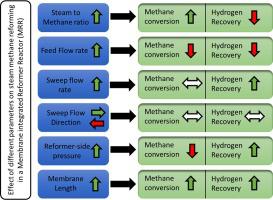Energy Conversion and Management ( IF 10.4 ) Pub Date : 2021-10-11 , DOI: 10.1016/j.enconman.2021.114838 Rached Ben-Mansour 1, 2 , M.D. Azazul Haque 2, 3, 4 , Aadesh Harale 5 , Stephen N. Paglieri 5 , Firas S. Alrashed 5 , Mohammad Raghib Shakeel 2 , Esmail M.A. Mokheimer 2, 3 , Mohamed A. Habib 2, 4

|
Steam-methane reforming is the primary method for industrial hydrogen production. High energy consumption and elevated greenhouse gas (GHG) emissions call for a significant improvement in the reforming process for optimum methane conversion and hydrogen production. Enhanced fuel conversion also produces more CO2 than CO, making the carbon capture process easier, consequently reducing harmful emissions. In this work, a membrane-integrated reformer reactor (MRR) has been investigated through an experimentally validated computational fluid dynamics (CFD) model using ANSYS-Fluent. The MRR model constitutes of Ni-based catalyst filled reforming zone, Pd-based hydrogen-selective membrane, and permeate zone for hydrogen recovery. The developed model has been examined for several parameters including steam-to-methane ratio, flow rate, sweeping conditions, flow direction, reformer pressure and membrane length. The results indicated a substantial increase in methane conversion with a higher steam-to-carbon (S/C) ratio for a given feed flow rate. The methane conversion increased from 34% to 63% when the S/C ratio is increased from 2 to 6 at a methane mass flow rate of 0.0018 kg/s. The results also indicate an increase in hydrogen recovery with the decrease in feed flow rate for a fixed steam-to-methane ratio. Hydrogen recovery decreased from 28% to 2% when the mass flow rate of methane is increased from 5 × 10-5 kg/s to 1.8 × 10-3 kg/s, at a fixed S/C of 4. The incorporation of sweeping steam demonstrated a significant improvement in hydrogen recovery increasing from 15% to 33% with a sweep flow rate equal to the feed flow rate and methane mass flow rate of 1.8 × 10-4 kg/s. Further increase in sweep flow rate showed very small increase in hydrogen recovery, therefore in order to minimize the use of sweeping steam, a sweeping steam flow rate equal to the feed flow rate is suggested. Furthermore, flow direction, reformer pressure and membrane length were also found to play vital role in MRR performance.
中文翻译:

使用 CFD 模型进行甲烷重整和氢气分离的综合参数研究
蒸汽-甲烷重整是工业制氢的主要方法。高能耗和增加的温室气体 (GHG) 排放要求对重整过程进行重大改进,以实现最佳的甲烷转化和制氢。增强的燃料转化也会产生更多的 CO 2比二氧化碳,使碳捕获过程更容易,从而减少有害排放。在这项工作中,使用 ANSYS-Fluent 通过实验验证的计算流体动力学 (CFD) 模型研究了膜集成重整反应器 (MRR)。MRR 模型由 Ni 基催化剂填充重整区、Pd 基氢气选择性膜和用于氢气回收的渗透区组成。开发的模型已针对几个参数进行了检查,包括蒸汽与甲烷的比率、流速、吹扫条件、流动方向、重整压力和膜长度。结果表明,对于给定的进料流速,随着蒸汽碳 (S/C) 比的升高,甲烷转化率显着增加。当甲烷质量流量为 0.0018 kg/s 时,当 S/C 比从 2 增加到 6 时,甲烷转化率从 34% 增加到 63%。结果还表明,对于固定的蒸汽与甲烷比率,随着进料流速的降低,氢气回收率增加。当甲烷的质量流量从 5 × 10 增加时,氢气回收率从 28% 下降到 2%-5 kg/s 到 1.8 × 10 -3 kg/s,在固定 S/C 为 4。吹扫蒸汽的加入表明氢气回收率显着提高,从 15% 增加到 33%,吹扫流速等于进料流速和甲烷质量流速为1.8×10 -4 kg/s。吹扫流速的进一步增加显示氢气回收率的增加很小,因此为了尽量减少吹扫蒸汽的使用,建议吹扫蒸汽流速等于进料流速。此外,还发现流向、重整压力和膜长度对 MRR 性能起着至关重要的作用。



























 京公网安备 11010802027423号
京公网安备 11010802027423号